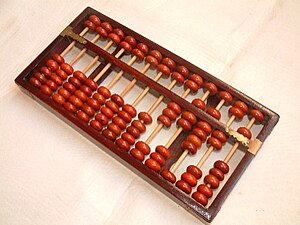Make Your Own Abacus with Popsicle Sticks
Make Your Own Abacus with Popsicle Sticks
How to Use an Abacus
Although I studied Chinese in college and have been to China three times, most recently this summer, I had never learned how to use an abacus until researching this activity.
If you understand simple addition and subtraction, you can use an abacus. With summer upon us, you probably have all the materials at hand. This activity would take 10 minutes to assemble if you didn’t have to wait for the glue to dry. As it is, it will take about an hour.
If you and your grandchild both make one, you can have races to see who can solve problems first!
Materials:
- 9 popsicle sticks
- 3 bamboo skewers
- 56 beads (Pony beads from Michael’s or the beads in a party favor pack for making bracelets from the Dollar Store). Can be the same or different colors. If different, it helps to have 16 beads of one color for the top beads, then the same color beads for each row below. I had 15 of one color and 41 in 5 colors. Make sure they will slip loosely on a bamboo skewer
- Pencil
- Glue (Elmer’s works fine; anything that will glue light wood to wood)
- Pruning shears
- Scrap paper
Instructions:
- Lay out the beads in the pattern they will be on the abacus. We are going to make an abacus with a 2:5 pattern, the ancient Chinese style (suan pan)
- Lay out 16 beads in 8 rows of 2, top to bottom on a piece of scrap paper
- Lay out 40 beads below them, in 8 rows of five, top to bottom, underneath the rows of 2.
- Using the pruning shears, cut the bamboo skewers into three four-inch pieces. You will have one extra that you don’t use.
- Lay the tips of the 8 bamboo skewers evenly along one of the popsicle sticks, starting one-half inch in from each end on a piece of scrap paper. From now on, work on top of the scrap paper so glue won’t get on the table, counter or desk where you are working
- Use the pencil to mark where the bamboo skewer tips lie on the popsicle stick
- Take the bamboo skewers off the popsicle stick and put glue on the 8 pencil marks
- Put the ends of the bamboo skewers on the glue marks
- Add additional glue over the ends of the bamboo skewers and lay a popsicle stick over the top of the bamboo skewers. Press down on the top popsicle stick firmly until the glue starts to set, then let dry for five minutes
- Slide 2 beads onto each of the eight bamboo skewers. It helps if they’re all the same color, but, if not, at least make each pair the same color
- After the glue is well set, slide a popsicle stick under the skewers about an inch and a half from the bottom of the popsicle stick at the top, leaving a little room below the 2 beads in each row
- Use a pencil to mark where the bamboo skewers hit the popsicle stick underneath, slide it out and put glue where the pencil marks are
- Put the frame on top of the glue marks on the popsicle stick, so the new popsicle stick is below the beads and about an inch and a half from the top popsicle stick. Press firmly for several minutes to start to set the glue. Let dry for five minutes
- Glue a popsicle stick on top of the skewers over the popsicle stick below the two beads. Press firmly, then let dry for five minutes
- Slide 5 beads onto each of the 8 bamboo skewers below the popsicle stick you have just glued.
- Slide a popsicle stick under the ends of the bamboo skewers, mark where the ends of the skewers hit with a pencil, slide out and put glue on the pencil marks.
- Put the frame on top of the popsicle stick with glue, press firmly, then let dry for 5 minutes.
- Glue another popsicle stick on top of the ends of the bamboo skewers
- Glue three more popsickle sticks over each of the three bands of popsicle sticks to provide extra space for moving the beads. This side is now the back of the abacus.
- Let glue dry for 10 minutes. Turn over to use.
What Should Happen?
You now have a working abacus in the style of those used in ancient China (suan pan), where the first bead and rod abacus was invented in the 11th century, probably based on a Roman counting tray. This kind of abacus was used in China up until 1850, when it was changed to a 1:4 layout, which is also the kind now used in Japan (soroban). The abacus was imported to Japan from China in the 15th century and was quickly modified to the 1:4 layout.
In 1978, when I first visited China, it was common for merchants to calculate sales on an abacus. If I didn’t understand a price, the clerk would show me the abacus to read.
How Do You Read an Abacus?
The two parts of the abacus, above and below the bar, are sometimes called Heaven and Earth beads, or the upper deck and lower deck. The two beads above the bar, or beam, each represent 5. The 5 beads below the bar each represent 1. The rows represent places in a number. That is, in the right-most row, the beads represent ones. In the second row from the right, the beads represent 10. That is, one bead below the bar means 10. One bead above the bar means 50 (5 x 10). In the third row from the right, the beads represent hundreds.
The rest of the rows, reading from right to left, represent thousands, ten thousands, 100 thousands, millions and tens of millions. To clear the abacus, you stand it up and let all the beads fall down to the bottom of the two bars. Then, move all the beads above the bar up to the top of their rows. (Some users move the top beads up toward the frame, others down toward the bar when they are calculating. Just decide if you are going to start with the upper beads at the top, or down near the bar and move them all there.)
When you enter a number, you enter it left to right, the same way we write a number. Thus, the number 573 would be entered on the abacus by moving one bead in the third column from the right, or the hundreds column, down from the top to the bar, to represent 500. Then, move one bead in the second row down to the bar to represent 50 and two beads up from the bottom to the bar to represent 20 (50+20 = 70). Then, move three beads from the right-most row up to the bar.
You read the abacus left to right, just like we read numbers: 500 + 70 + 3 = 573.
Optional: Addition: Add large numbers, like 573 + 1,074. If you don’t have enough beads so the lower deck, add one from the upper deck and subtract the number of beads from the lower deck to leave the number you need. Add the numbers from left to right.
Optional: Multiplication. Multiply large numbers by storing them on opposite sides of the abacus, then multiplying the right-most digit (7 of 87) of one number by the left-most digit of the other number (6 of 625) and accumulate the total on the abacus. Thus, 7 x 600 + 7 x 20 + 7 x 25 + 80 x 600 + 80 x 20 + 80 x 5).
Click here to see a step-by-step explanation of multiplication on a Chinese 2:5 abacus.
Why Is This Useful?
With this simple device, you can precisely add, subtract and multiply complex numbers easily, in minutes. Until trigonometric functions were added to calculators, people skilled with an abacus could routinely outperform someone using a calculator. Now, calculators have replaced the use of the abacus in most of Asia.
Children are still being taught how to use the calculator as an early mathematical tool, to preserve their cultural heritage and to compete in speed contests. In rural areas, without electricity, the abacus is still in use. For the blind, a calculator is a powerful tool for learning mathematics.
Thank you to a picture in Pinterest.com for inspiring this activity and to rockhopperroom19.blogspot.com for detailed instructions.
If you’d like some practice on the abacus, here are some demos:
- Click here for a kids’ video on how to count using the Japanese abacus
- Click here for kids video on how to add on the Chinese abacus
- Click here to learn how to add on the Chinese abacus
- Click here for an introductory tutorial on the abacus for parents
- Click here for a tutorial for parents on addition using the abacus
- Click here to see an interactive demo to let you move beads and see the numbers appear
- Click here for some addition and subtraction problems on an abacus
And, now you have your own abacus and know how to use it!
Carol Covin, Granny-Guru
Author, “Who Gets to Name Grandma? The Wisdom of Mothers and Grandmothers”
http://newgrandmas.com
Don’t forget to follow Grandmother Diaries via Geek Girl on Facebook and Twitter.
Filed in: arts & crafts & educational • DIY • education • Playtime




Using an abacus really helped me to learn how to count better when I was little. Being able to see the beads, and move them made numbers much more concrete to me than just numerals on a page. I can see how this would be a great activity for kids.
When I was a kid I thought an abacus was exotic and mysterious. You learned early, Jeri, that it is concrete and intuitive.
Because I was a tactual learner and abacus was instrumental in my ability to visualize a problem and helped me see the solution. I always had them in my classroom and used them when a child was challenged in their math skills. 🙂 They saw it as a game and it made it much more fun for both they and me. 🙂
This is a fabulous project for me to do with my girls this summer! Sabrina my six year old, loves to count and do math so she will love this. I was a Chinese major in college. Didn't know you had studied it as well! How fun. I've only been to China once though, and that wasn't until 1996! I played interpreter for a week for a friend of mine who was traveling the world interviewing fathers and sons for a film he was making. It was a wonderful experience. I never used an abacus in school or in China so it will be fun learning! Thanks !
What a good idea.
I actually never really understood exactly how they worked, so thank you for that 🙂